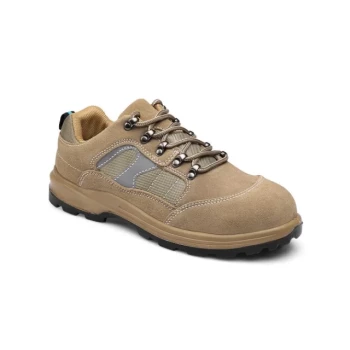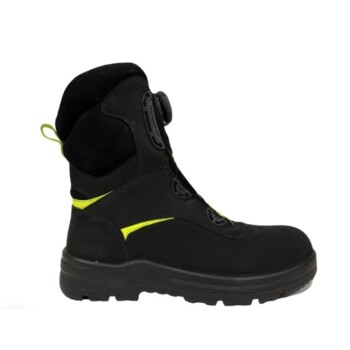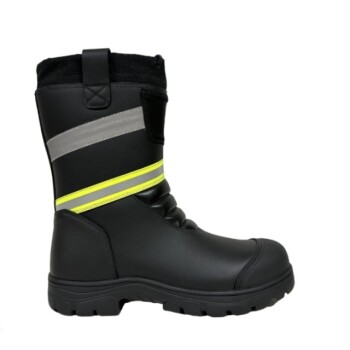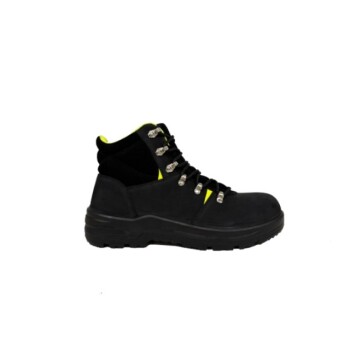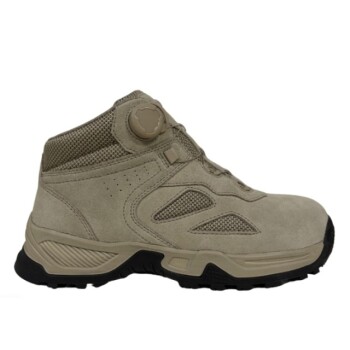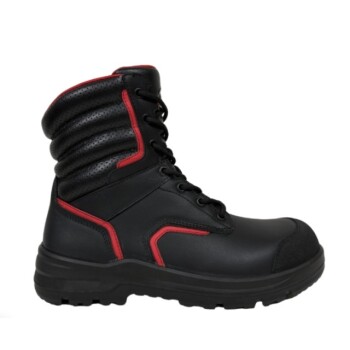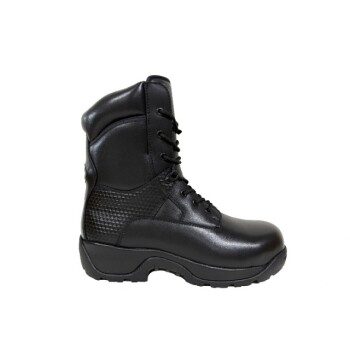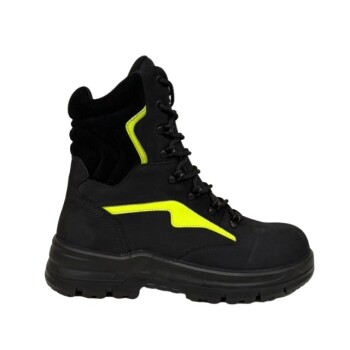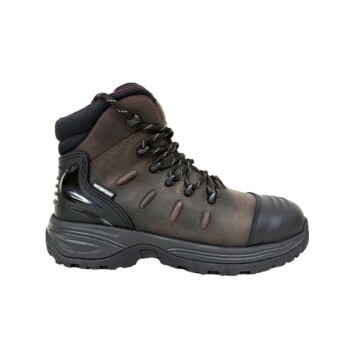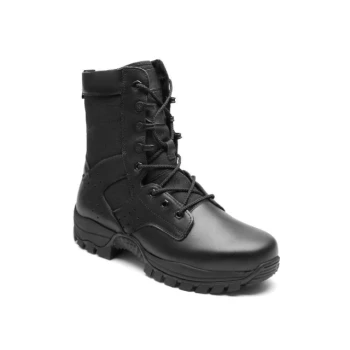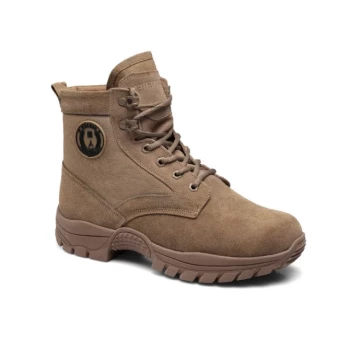No, moc toe boots are not suitable for all jobs. They are purpose-built for roles that demand a specific blend of comfort, flexibility, and durability on hard surfaces. While they excel in these environments, they lack the specialized protective features and designs required for more extreme or hazardous job sites.
The core strength of a moc toe boot is its superior all-day comfort and spacious fit, making it ideal for tradespeople on their feet. However, this design comes with trade-offs, and it is less suited for work requiring extreme stability on uneven terrain or top-of-foot impact protection.

The Core Strengths of the Moc Toe Design
Moc toe boots are defined by their Moccasin-style stitched toe box. This construction isn't just for looks; it directly impacts the boot's performance and feel.
Built for All-Day Comfort
The primary advantage of the moc toe is comfort. Most are built with thick rubber wedge soles that are excellent at absorbing the impact of walking on hard surfaces like concrete or asphalt.
This makes them a preferred choice for workers who spend long hours standing or moving in factories, workshops, and on construction sites.
A More Accommodating Fit
The stitched construction of the toe box creates higher side walls and a roomier, more rounded tip.
This design provides more vertical and horizontal space for your toes, making moc toe boots a favored option for individuals with wider feet.
Durable and Flexible Construction
The design is inherently durable and flexible, allowing for a natural foot movement that is crucial for jobs involving frequent kneeling or squatting.
This combination of durability and flexibility is essential for trades like carpentry, plumbing, and electrical work.
Understanding the Trade-offs and Limitations
While moc toe boots are exceptional in their intended roles, they are not a universal solution. Understanding their limitations is critical for making a safe and effective choice.
Not All Moc Toes Are Safety Boots
The term "moc toe" refers to the style of construction, not a set of safety features. While many moc toe boots are available with steel or composite safety toes, you must always verify the specific safety ratings.
They can also include features like electrical hazard (EH) resistance and slip-resistant outsoles, but these are not standard on every pair.
Unsuitable for Metatarsal Protection
This is a critical safety limitation. The stitched design of the moc toe is generally incompatible with metatarsal guards, which protect the delicate bones on the top of the foot from falling objects.
Jobs that carry a high risk of top-of-foot impact require a different style of boot, typically a plain or round toe designed to accommodate this extra protection.
Less Ideal for Unstable or Messy Terrains
For work on rugged, uneven ground like logging or forestry, a logger boot is superior. Logger boots feature a high, defined heel and an aggressive lug sole designed to provide stability and grip on soft, unpredictable surfaces.
Furthermore, the seams on a moc toe can trap mud and debris, making a plain toe boot a more practical, easier-to-clean option for exceptionally messy environments.
Making the Right Choice for Your Job
Selecting the correct work boot is about matching the tool to the task. Use these guidelines to determine if a moc toe is right for you.
- If your primary focus is all-day comfort on hard surfaces: A moc toe boot is an excellent choice, especially for trades like carpentry, factory work, and general construction.
- If your primary focus is stability on uneven, natural terrain: You should consider a logger-style boot with a defined heel and aggressive tread.
- If your primary focus is protection from falling objects: You must find a boot with a certified safety toe and, if required, a metatarsal guard, which is rarely found on moc toe styles.
- If your primary focus is working in extremely muddy or dirty conditions: A plain toe boot offers a simpler surface that is significantly easier to clean and maintain.
Choosing the right boot means matching its specific design strengths to the unique demands of your work environment.
Summary Table:
| Job Type | Is a Moc Toe Boot Suitable? | Key Considerations |
|---|---|---|
| Factory/Workshop Work | ✅ Highly Suitable | Superior comfort on hard surfaces, flexible for kneeling. |
| Carpentry, Plumbing, Electrical | ✅ Highly Suitable | Durable, flexible, and offers a roomy fit. |
| Uneven Terrain (Logging, Forestry) | ❌ Not Suitable | Requires a logger boot with a defined heel for stability. |
| High Risk of Top-of-Foot Impact | ❌ Not Suitable | Needs a metatarsal guard, which is incompatible with moc toe design. |
| Extremely Muddy/Dirty Conditions | ❌ Less Suitable | Plain toe boots are easier to clean; moc toe seams trap debris. |
Need the Right Boots for Your Team?
As a large-scale manufacturer, 3515 produces a comprehensive range of footwear for distributors, brand owners, and bulk clients. Whether you need the all-day comfort of moc toe boots for your factory staff or specialized safety boots for hazardous environments, our production capabilities encompass all types of shoes and boots to meet your exact specifications.
Let us help you equip your workforce with the perfect footwear. Contact our team today to discuss your needs and get a quote.
Visual Guide
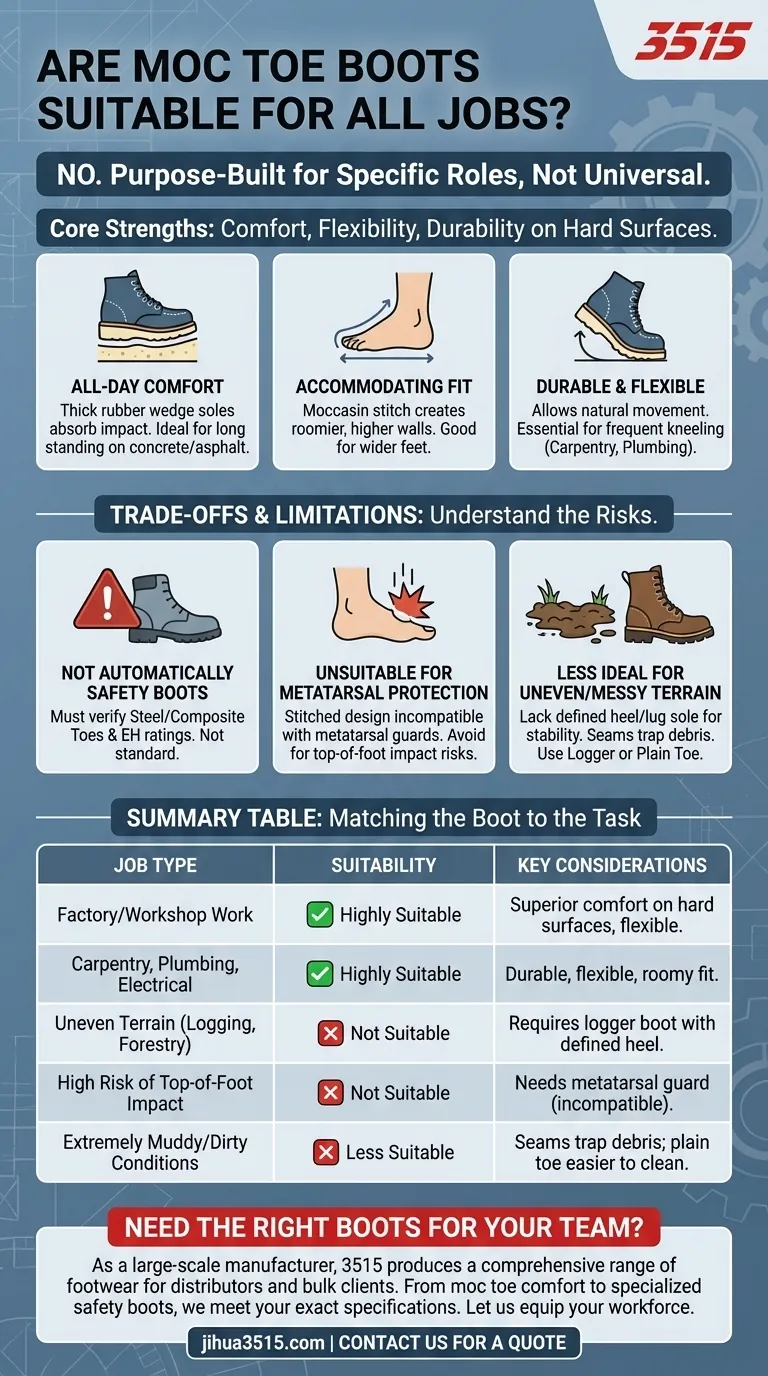
Related Products
- Wholesale Safety Boots Manufacturer for Custom & Private Label Orders
- Premium High-Cut Waterproof Safety Boots Manufacturing & Wholesale Solutions
- High Performance Fire-Retardant Waterproof Safety Boots
- Durable Goodyear Welt Leather Work Boots for Wholesale & Private Label
- Heavy-Duty Waterproof Nubuck Safety Boots Safety Shoes for Bulk Supply
People Also Ask
- What are the consequences of not wearing safety shoes? Protect Your Feet from Severe Workplace Injuries
- What tips should be followed when buying oilfield work boots? Choose the Right PPE for Safety & Comfort
- What type of personal protective equipment does OSHA require? A Guide to Hazard-Based Compliance
- What advice is given for selecting the right boots? A Step-by-Step Guide to Finding Your Perfect Fit
- What type of footwear is required for mechanics? The Ultimate Guide to Garage Safety Boots
